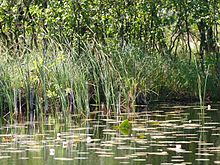Narrow-leaved cattail
| Narrow-leaved cattail | ||||||||||||
|---|---|---|---|---|---|---|---|---|---|---|---|---|

Narrow-leaved cattail ( Typha angustifolia ) |
||||||||||||
| Systematics | ||||||||||||
|
||||||||||||
| Scientific name | ||||||||||||
| Typha angustifolia | ||||||||||||
| L. |
The Narrow cattail ( Typha angustifolia ) is a plant species in the family of typhaceae (Typhaceae).
description
The narrow-leaved cattail is a perennial, herbaceous plant that reaches heights of 1 to 2 meters. The subterranean runners of the plant are about 1 cm thick, mostly creeping horizontally for a short time and then erect. The stems are leafy. The leaves are (3 to) 5 to 8 (to 10) mm wide. The leaf sections have nine distinct and two to four smaller marginal air chambers.
The male flowers are equipped with perigone hairs . Male and female flower cobs are separated by a (1.5 to) 2.5 to 3.5 cm long flowerless section. The female cobs are 2.5 to 4 cm long and dark brown. The male cobs at the top of the plant are two to three times as long.
The chromosome number of the species is 2n = 30.
distribution
The narrow-leaved cattail is widespread in the temperate zones of the northern hemisphere.
ecology
The silting pioneer usually has short subterranean runners that are used for vegetative reproduction. Its flowers are proterogynous , anemogamous and self-fertile . The male flowers should not open until three days after the female flowers; if no cross- pollination has taken place by then , self-pollination can occur. The flowering period is between June and August.
Locations
One meets this plant species quite rarely on banks or in ditches, in the reed beds mainly standing or slowly flowing, warm, often lime-poor water over humus muddy soil. According to Ellenberg , it is a light plant, an alternating water pointer, a weak acid to weak base pointer, prefers nitrogen-rich locations, carries salt and a type of character of the association Typhetum angustifolii from the association of the still water reed beds in fresh water (Phragmition australis). As a silting pioneer, it often forms pure stands, but is still occasionally overlooked because the non-flowering specimens often predominate.
use
food
The rhizomes can be cooked and eaten similar to the potato. Ten times the amount of rhizomes can be harvested on one hectare, as if potatoes were growing there (approx. 350 tons of fresh rhizomes). The rhizomes make a flour that is well suited for baked goods. Dried rhizomes consist of 46% starch and sugar and at least 20% fiber. Cattail meal contains more fat than corn, rice, wheat and potato flour. It contains more minerals and carbohydrates than potato flour and more protein than corn and rice. Furthermore, young shoots, pulp, flowers and pollen are edible.
textiles
The leaves contain around 25-35% fiber. These can be obtained through a chemical-technical separation. They were used for furniture plugs, burlap, and coarser yarn. They can be compared to linen, hemp, sisal, and jute. It should be possible to obtain around 10 tons of fibers per hectare.
Technical recovery
You can make paper from cattails. Furthermore, fiber-rich parts (leaves and stems) can be used to make fiberboard, cellulose, fodder, litter and ethyl alcohol. Ethyl alcohol can also be made from the rhizomes.
Other uses
The cattail flakes can be used as a kapok substitute. According to Vagn J. Brǿndegaard, the oil from the seeds is suitable both as edible oil and as a raw material for industrial uses. The species is used as an ornamental plant for the decorative design of bank areas. The seeds make great tinder and were used in ancient times to light a fire.
literature
- Erich Oberdorfer : Plant-sociological excursion flora for Germany and neighboring areas . 8th edition. Stuttgart, Verlag Eugen Ulmer, 2001. Page 115. ISBN 3-8001-3131-5
- Heinz Ellenberg : Vegetation of Central Europe with the Alps from an ecological, dynamic and historical perspective. 5th, heavily changed and improved edition. Ulmer, Stuttgart 1996, ISBN 3-8001-2696-6 .
Individual evidence
- ↑ a b Erich Oberdorfer : Plant-sociological excursion flora for Germany and neighboring areas . With the collaboration of Angelika Schwabe and Theo Müller. 8th, heavily revised and expanded edition. Eugen Ulmer, Stuttgart (Hohenheim) 2001, ISBN 3-8001-3131-5 , pp. 115 .
- ↑ Rafaël Govaerts (ed.): Typha angustifolia. In: World Checklist of Selected Plant Families (WCSP) - The Board of Trustees of the Royal Botanic Gardens, Kew . Retrieved June 5, 2020.
- ↑ http://www.kslab.ksla.se/Brondegaard/artiklar/175.pdf ( Page no longer available , search in web archives ) Info: The link was automatically marked as defective. Please check the link according to the instructions and then remove this notice.
Web links
- Narrow-leaved cattail. In: FloraWeb.de.
- Narrow-leaved cattail . In: BiolFlor, the database of biological-ecological characteristics of the flora of Germany.
- Profile and distribution map for Bavaria . In: Botanical Information Hub of Bavaria .
- Typha angustifolia L., map for distribution in Switzerland In: Info Flora , the national data and information center for Swiss flora .
- Distribution in the Netherlands [1] (Dutch)
- Distribution in the northern hemisphere according to Eric Hultén [2]
- Thomas Meyer: Data sheet with identification key and photos at Flora-de: Flora von Deutschland (old name of the website: Flowers in Swabia )
- Typha angustifolia inthe IUCN 2013 Red List of Threatened Species . Posted by: Zhuang, X., 2010. Retrieved April 11, 2014.
